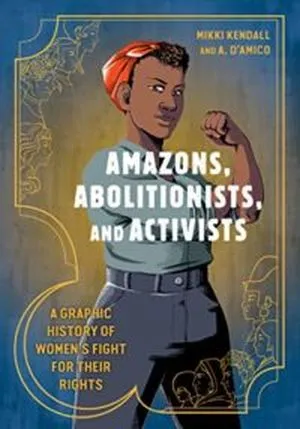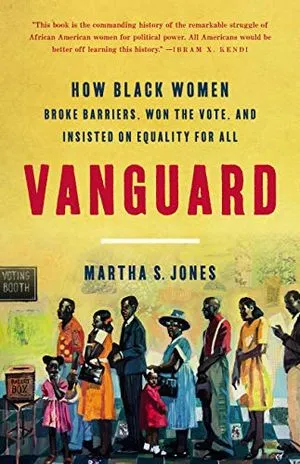
8 Books About the History of Women’s Suffrage in America
On August 18, 1920, women in the United States won the right to vote. Well. Not all women. Legally, Black and white women could vote after the passage of the 19th amendment, but it would be four more years until American Indians could vote and 23 years until Chinese Americans could vote. Voting in America has stood as a symbol of equal rights for citizens. Even a literalist view of “all men are created equal” begs the question that, if Jefferson believed that, why did we disenfranchise approximately 94% of voters in the first presidential election? Since that election in 1788, we have slowly worked towards true equality, at least as regards the vote. Women won it after decades of fighting. This year marks 100 years of that right being recognized, out of almost 225 years of the United States’s existence. Let’s hope we begin to move a little faster.

African American Women in the Struggle for the Vote, 1850-1920 by Rosalyn Terborg-Penn
Co-founder of the Association of Black Women Historians Terborg-Penn offers a slim but dense look into the role of African American women in the fight for the ballot. She covers the period from the immediate aftermath of the Seneca Falls Convention to the passing of the 19th in 1920, and walks you through suffrage strategies, African American women’s organizations of the nineteenth century, and anti-Black woman tactics and their response. A great primer.
The Scarlet Sisters: Sex, Suffrage, and Scandal in the Gilded Age by Myra MacPherson
You might have heard that Victoria Woodhull was the first woman to run for president, but did you know she and her sister were the first to open a brokerage firm on Wall Street? Or that they worked as mediums? Or that Woodhull’s nickname was Madam Satan? Woodhull and her sister Tennessee Claflin made a splash in the early 1870s, but their history extends far beyond and before that time.

The Women’s Suffrage Movement, ed. by Sally Roesch Wagner
If you love primary sources, this is for you. Starting in the 1830s, this collection gathers newspaper articles, petitions, letters, book excerpts, and more. Sure, we all know bloomers were a thing, but what was Elizabeth Cady Stanton’s opinion on them? How did the women’s movement respond to “free love” in the 19th century? As with most collections of its kind, it’s ideal for reading as your whims take you, as opposed to a chronological go-through (although that works too!). Perfect for the history nerd.

The Woman’s Hour: The Great Fight to Win the Vote by Elaine Weiss
The last weeks of the fight for the 19th amendment were dramatic, to say the least. Ratification came down to one state: Tennessee. Pro- and anti-suffrage forces gathered there and who would win! (we know who would win, but still.) While Weiss shows a fair amount of bias towards Carrie Chapman Catt and her organization, it’s a compellingly told and well-researched history of the final fight for the 19th.
Amazons, Abolitionists, and Activists: A Graphic History of Women’s Fight for Their Rights by Mikki Kendall, illustrated by A. D’Amico
This graphic history takes a more zoomed-out approach to the history of women’s rights. Kendall starts in antiquity, moves to slavery, colonialism, and imperialism, and then suffrage, civil rights, and women’s rights from the ’60s to today. It’s easy for women’s rights to be centered around the ballot when there is so much more to it. This is excellent for placing it in its context, while also considering those left out of the process.
Why They Marched: Untold Stories of the Women Who Fought for the Right to Vote by Susan Ware
Do you love stories? Of course you do, you’re human. Ware focuses on individual stories to tell the history of women’s suffrage in America from many vantage points. From Sojourner Truth to The Yellow Wallpaper‘s Charlotte Perkins Gilman, and from Ida Wells-Barnett and the Alphabet Suffrage Club to feminist cartoons of the 1910s, Ware focuses on the latter days of women’s suffrage (primarily the 1880s to the 1920s).

She Votes: How U.S. Women Won Suffrage, and What Happened Next by Bridget Quinn
Aren’t you so glad the art of the letterpress is returning? This book is beautiful, with illustrations from 100 women artists. It talks about the influence of the Haudenosaunee, the riot grrrl movement, Patsy Matsu Takemoto Mink and her sponsoring of Title IX, and so much more. It’s definitely worth having on your shelf.
Vanguard: How Black Women Broke Barriers, Won the Vote, and Insisted on Equality for All by Martha S. Jones
The 19th amendment passed in 1920, but many, many women were left out of enfranchisement. While Black women legally had the vote, they were cut off from voting by poll taxes, intimidation, and whatever other devious methods those in power could devise. Jones tells the story of how Black women won the vote, highlighting a few like 19th century poet and activist Frances Ellen Watkins Harper, and co-founder of the Democratic Freedom Party Fannie Lou Hamer, among others.
- Anti-Suffragette Literature: Not So Different From Modern Media After All
- Learn About Women’s Suffrage Movements Across the Globe
- Young People Have Always Been Radicals: Suffrage in YA Fiction
- 11 Great Biographies of U.S. Suffragists
- 6 Books to Bring Together Women’s Suffrage and Labor Movements
- Poetry From the Suffrage Movement
- What’s She Got In Her Pocketses? Women’s Suffrage and Pockets
- 5 Books About the Influence of Black Women in the Suffrage Movement




